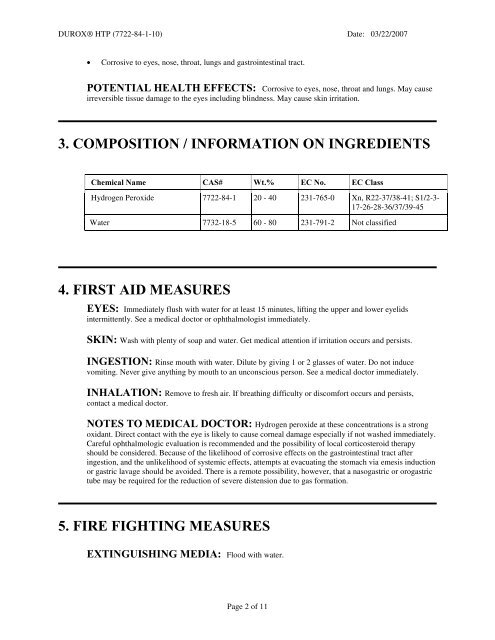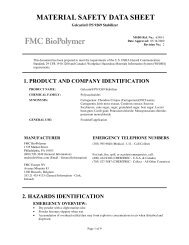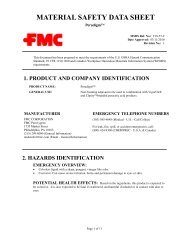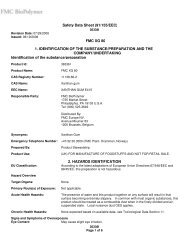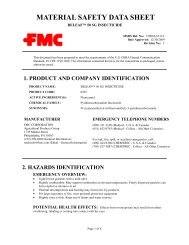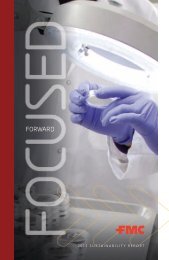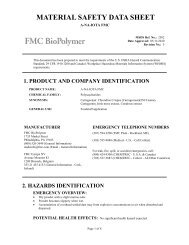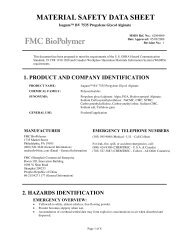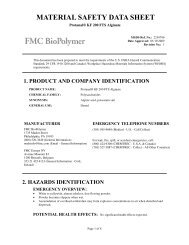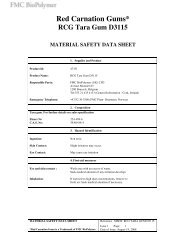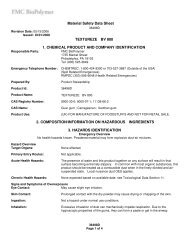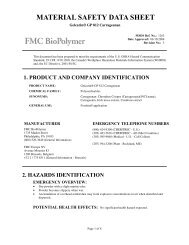material safety data sheet - FMC Corporation
material safety data sheet - FMC Corporation
material safety data sheet - FMC Corporation
You also want an ePaper? Increase the reach of your titles
YUMPU automatically turns print PDFs into web optimized ePapers that Google loves.
DUROX® HTP (7722-84-1-10) Date: 03/22/2007<br />
• Corrosive to eyes, nose, throat, lungs and gastrointestinal tract.<br />
POTENTIAL HEALTH EFFECTS: Corrosive to eyes, nose, throat and lungs. May cause<br />
irreversible tissue damage to the eyes including blindness. May cause skin irritation.<br />
3. COMPOSITION / INFORMATION ON INGREDIENTS<br />
Chemical Name CAS# Wt.% EC No. EC Class<br />
Hydrogen Peroxide 7722-84-1 20 - 40 231-765-0 Xn, R22-37/38-41; S1/2-3-<br />
17-26-28-36/37/39-45<br />
Water 7732-18-5 60 - 80 231-791-2 Not classified<br />
4. FIRST AID MEASURES<br />
EYES: Immediately flush with water for at least 15 minutes, lifting the upper and lower eyelids<br />
intermittently. See a medical doctor or ophthalmologist immediately.<br />
SKIN: Wash with plenty of soap and water. Get medical attention if irritation occurs and persists.<br />
INGESTION: Rinse mouth with water. Dilute by giving 1 or 2 glasses of water. Do not induce<br />
vomiting. Never give anything by mouth to an unconscious person. See a medical doctor immediately.<br />
INHALATION: Remove to fresh air. If breathing difficulty or discomfort occurs and persists,<br />
contact a medical doctor.<br />
NOTES TO MEDICAL DOCTOR: Hydrogen peroxide at these concentrations is a strong<br />
oxidant. Direct contact with the eye is likely to cause corneal damage especially if not washed immediately.<br />
Careful ophthalmologic evaluation is recommended and the possibility of local corticosteroid therapy<br />
should be considered. Because of the likelihood of corrosive effects on the gastrointestinal tract after<br />
ingestion, and the unlikelihood of systemic effects, attempts at evacuating the stomach via emesis induction<br />
or gastric lavage should be avoided. There is a remote possibility, however, that a nasogastric or orogastric<br />
tube may be required for the reduction of severe distension due to gas formation.<br />
5. FIRE FIGHTING MEASURES<br />
EXTINGUISHING MEDIA: Flood with water.<br />
Page 2 of 11


